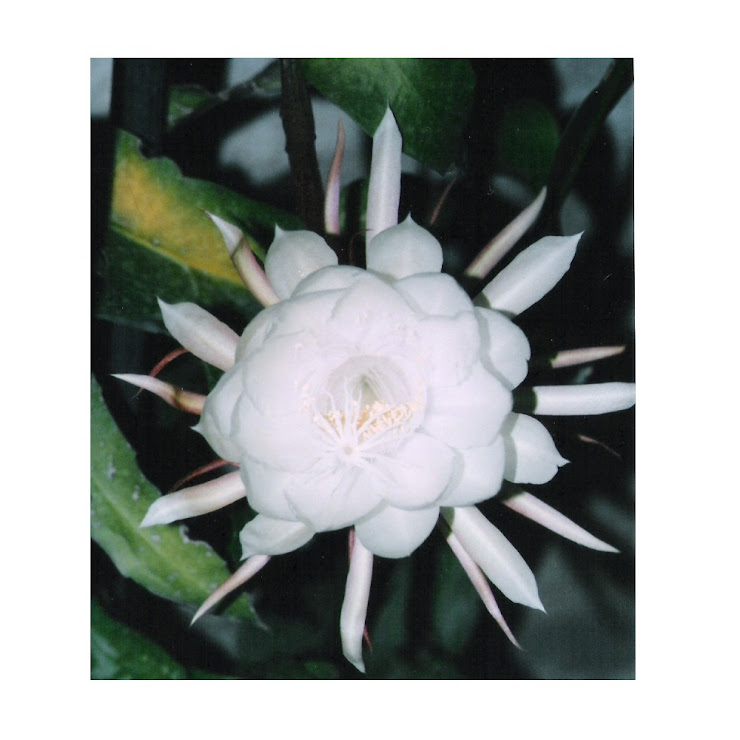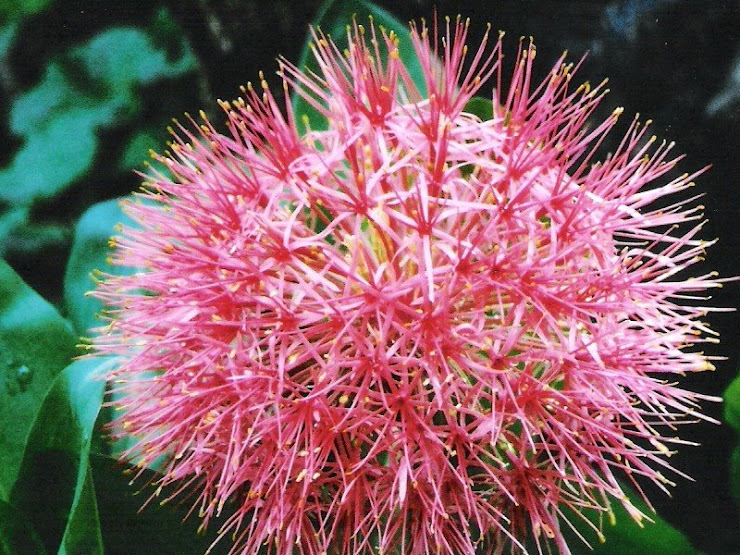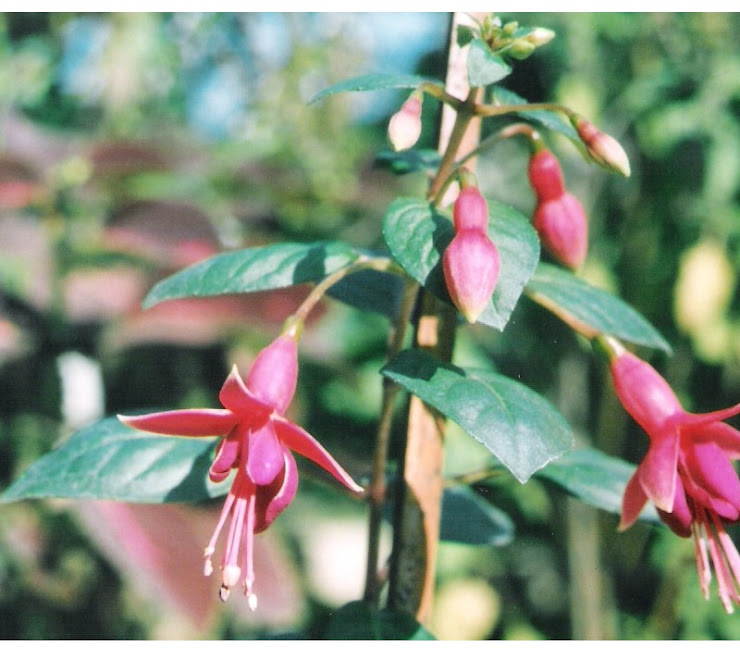KIWI
– GROWING IN THE GARDEN
Kiwi fruit is the edible fruit of Actinidia Deliciosa, and
hybrids between this species and others in the genus Actinidia.
Kiwifruits owe their name to a bird, native of New Zealand,
named "kiwi", and actually in many regions of Europe, North America
and South America, kiwi fruits are generally referred to as "kiwi"
This fruit consists of a hairy, brown peel containing green
flesh, with white pulp in the center, surrounded by black, edible seeds. The
fruit has a sweet taste, similar to a mixture of banana, pineapple and
strawberry. Kiwi fruits are native to China, where they were called
"macaque peach".
Nutrition-wise,
kiwi fruits contain about as much potassium as bananas, and also contain 1.5
times the DRI for Vitamin C. It is also rich in Vitamins A and
E, and its black seeds can be crushed to produce kiwi fruit oil, which is very
rich in Alfa-Linoleic Acid (an important Omega-3 essential fatty
acid)
Sliced Kiwifruits
Studies have proven that kiwifruits are useful in improving
conditions of asthmatic children, and in decreasing the probability of colon
cancer by providing a good amount of dietary fiber, for more information please
refer to our kiwifruit health benefits page
Please be aware that kiwifruits can be allergic to some
individuals, since they contain the protein-dissolving enzyme
"actinidin". The most common symptoms include itching of the mouth,
lips and palate, but can range to a more severe level such as wheezing or
collapsing
The part where it gets more interesting is actually the history
of kiwifruit : you will learn that they originated from China and were unknown
to the western world until as late as the 20th century!
Enjoy the benefits of this delicious fruit and don't forget to
bookmark this site for future reference!
HEALTH
INFO
Kiwi fruits are rich in many Vitamins,
flavonoids and minerals. In particular, they contain a high amount of Vitamin C (more than oranges), as much potassium as bananas
and a good amount of beta-carotene.
Studies in Italy, though, performed on 6-7
year old children, have also demonstrated additional health benefits to the
respiratory tract. In particular, children that were fed 5-7 portions a week of
citrus and kiwifruits had 44% less probability wheezing compared to children
eating less than once a week.
Shortness of breath was reduced by
32%,night time cough by 27%, severe wheeze by 41%, chronic cough by 25%, and
runny nose by 28%. This results is not only traceable to the content in Vitamin
C or Potassium, but in substances which are still largely unknown contained in
kiwi fruit.
These substances are most likely flavonoids
that help protect our cells from oxidative damage, and are therefore considered
very helpful in protecting our DNA from mutations and damage.
Protection from Age-Related Macular
Degeneration (ARMD)
A series of studies published by the
Archives of Ophthalmology have proven that consuming 3 or more servings of
fruit per day (including kiwi fruits) can reduce by 36% the risk of developing
an eye-related disease called ARMD (the primary cause of vision impairment in
adults), if compared to people who only consume 1.5 servings of fruit per day.
The study was conducted on 110.000 women
and men and lasted several decades. Surprisingly, the study found that while
vegetables were not correlated with an improved resistance to the disease,
fruits containing high amount of Vitamin C,A and E (the most common antioxidant
vitamins) helped significantly in protecting against ARMD
.
Anti Oxidant properties of Kiwi Fruit
It is important to note that kiwi fruits
contain a remarkable amount of Vitamin C, E and A. Vitamin C is a water-soluble
antioxidant that has been proven to protect our body from free radicals,
dramatically improving the health of individuals who consumed it regularly
against all kinds of disease, from cardiovascular problems
to cancer and obesity.
Vitamin E has been proven to
have similar effects, but is fat-soluble and thus is complimentary to Vitamin C
in its functions. Kiwi fruits contain both these vitamins in high amount, which
help protect our body against free radicals from all fronts.
Kiwi fruits have a high fiber content
The high content in dietary
fiber helps improving diseases such as diabetes, by controlling sugar levels,
and cancer color, since fiber binds to toxic compounds in the colon and helps
us expel them.
Fiber has also been proven to reduce
cholesterol levels, improving the conditions of patients with cardiovascular diseases and lowering the probability of
heart attacks.
Summary of Kiwifruit Health Benefits
Eating kiwi fruit is clearly a healthy
choice, and it is particularly useful in these cases:
Prevents
Asthma
Prevents
wheezing and coughing, especially in children
Protects
our DNA from mutations
Provides
a healthy amount of antioxidants and vitamins
Helps
prevent colon cancer thanks to a high fiber content
CULTIVATION OF
KIWIFRUIT
|
Kingdom
|
Plantae - Plants
|
|
Subkingdom
|
Tracheobionta - Vascular plants
|
|
Superdivision
|
Spermatophyta - Seed plants
|
|
Division
|
Magnoliophyta - Flowering plants
|
|
Class
|
Magnoliopsida - Dicotyledons
|
|
Subclass
|
Dilleniidae
|
|
Order
|
Theales
|
|
Family
|
Actinidiaceae - Chinese Gooseberry family
|
|
Genus
|
Actinidia Lindl. - Actinidia
|
|
Species
|
Actinidia Deliciosa - Kiwi Fruit
|
The kiwifruit tree, or Actinidia Deliciosa is
native of the Yangtze region of China, and was imported to New Zealand in the
early 20th century.
Kiwifruit Adaptation
Kiwifruit plants need at least 240 frost-free days, and they're
pretty susceptible to sudden drops in temperature in early autumn or late
winter. They can withstand a temperature of about 10°F when fully dormant, but
they're still vulnerable to sudden lower temperature and must acclimate slowly.
Late winter freezes will usually kill all the buds, and possibly
cause trunk splitting which severely damages the plant. Generally, if peaches,
almonds and citrus can survive, so can kiwi fruits.
The Hayward cultivar needs a winter rest of 800 hours between
32°F and 45°F, whereas the needs of other cultivars vary very widely: if the
winter is too mild the plant may not lose its leaves and subsequently fail to
flower.
Choosing a site for
Kiwifruit Cultivation
The best site to plant a kiwi fruit tree in in moderately sunny
place, where they can ramble across a trellising system. They will tolerate a
light shade, if needed. Vines should be protected from strong winds, since they
can snap off new growth.
The soil should be acidic, with a pH of about 5-6.5, rich in
organic matter and not too salty. If the soil is too basic, leaves will show
nitrogen deficiency.
Water is fundamental to kiwifruit plants: they should be planted
on a well drained soil and watered constantly, especially in summer when they
usually undergo the most stress. Water is the single most important cause of
kiwifruit tree exfoliation: leaves will usually turn brown and fall off if the
plant has to endure constant stress.
A Kiwifruit Orchard
Kiwifruit trees need a lot of nitrogen, especially in the early
season, so add a nitrogen-rich fertiliser early on.
Adding nitrogen in late season may cause the fruit to store poorly, so it's a
best practice to avoid overdoing it. Early fertilizations can be done with an
avocado tree fertilizer, while watering well, around March. Subsequent
fertilization can be done in early summer.
Mulching is also recommended, using manure or straw, even though the mulch should not come in direct contact with the vine.
Pruning is very important for adequate fruiting: since the vine
usually grows on a wire or t-bar system, it shold be pruned where it forms a
"pigtail" shape, at the end of the growth spurt.
How to plant a Kiwi Fruit
You can purchase a kiwi fruit seeds in a
store, and plant them in spring, in a moist planted (but not soaking with
water). In about 5 weeks, the seeds will germinate: at that point they will
need grafting to allow for better plants and to produce known sex plants.
If you intend to purchase a grown plant, it is slightly better
to choose the cutting grown (the other choice being a grafted plant), since it
usually withstands winter freezes better.
Pests and diseases are not a big problem to kiwifruit plants,
since the soil they grow on is not usually home to pests. However, the plant
attracts animals like cats (that love to rub against new shoots, damaging
them), deer, garden snails and gophers. Be wary of root-rot nematodes that may
weaken the plant, especially in its young stage.
Kiwi fruit should be harvested around mid-november, when the
seeds are completely black. It can then be stored in a plastic bag, inside a
refrigerator, where it can last up to several months. It can also be further
ripened if kept in a plastic bag, at ambient temperature.









No comments:
Post a Comment